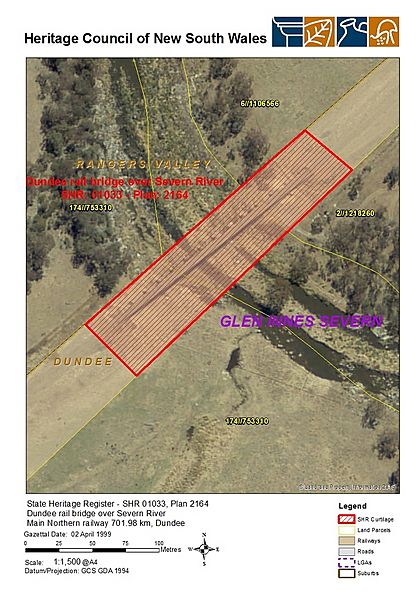Severn River railway bridge, Dundee facts for kids
Quick facts for kids Dundee rail bridge over Severn River |
|
|---|---|

Heritage boundaries
|
|
| Coordinates | 29°34′55″S 151°48′10″E / 29.5820°S 151.8027°E |
| Carries | Main North line |
| Crosses | Severn River |
| Locale | Dundee, Glen Innes Severn, New South Wales, Australia |
| Other name(s) | Severn River Railway Viaduct |
| Owner | RailCorp |
| Characteristics | |
| Design | Queen post truss bridge |
| Material | Timber |
| Longest span | 12 metres (40 ft) |
| Number of spans | 13 |
| History | |
| Engineering design by | John Whitton |
| Construction end | 1886 |
Official name:
|
|
| Type: | State heritage (built) |
| Designated: | 2 April 1999 |
| Reference #: | 1033 |
| Type: | Railway Bridge/ Viaduct |
| Category: | Transport - Rail |
| Builders: | Main Contractor for the Glen Innes to Tenterfield section |
The Severn River railway bridge is a special old railway bridge that carries the main train line, called the Main North line. It crosses the Severn River in a place called Dundee, Australia. This bridge was designed by John Whitton, who was the chief engineer for railways, and it was built in 1886. It's also known as the Severn River Railway Viaduct. The bridge is owned by RailCorp, which is part of the New South Wales government. It was officially listed as a special heritage site on 2 April 1999.
How the Bridge Was Built
Building the Main North Railway Line
John Whitton was the chief engineer for railways from 1856 to 1890. He was in charge of extending the Main North Railway. This railway line went from Muswellbrook all the way to Glen Innes between 1870 and 1884.
Building this part of the railway was very difficult and expensive. The tracks had to climb through the highest parts of the Great Dividing Range into the New England Region. This meant the slopes were steep, the curves were sharp, and a lot of earth had to be moved. Some big iron bridges were also needed.
Saving Money on Bridges
When they planned the next part of the railway, from Glen Innes to Tenterfield, they looked for ways to save money. Bridges were one area where they could cut costs. They decided to use timber for most bridges, especially for those with a flat top for the train tracks.
However, three places needed bigger bridges: over the Beardy Waters, the Severn River, and the Bluff River.
Whitton's Bridge Design Choice
Whitton, who was a very successful railway engineer from England, chose a design from one of Isambard Kingdom Brunel's timber bridges. Brunel was another famous engineer who built bridges in Cornwall, England, in the 1850s.
The design Whitton chose was like the St Germans Viaduct. This bridge used a special type of truss called a "Queen post truss." Originally, these trusses had large iron rods at the bottom. But Whitton's team changed the design so that the entire truss was made of timber. These new timber bridges were built between 1884 and 1886.
Other Similar Bridges
The final part of the railway line went to Wallangarra in 1888. This section was mostly easier to build because it crossed flatter land. But they still needed a large bridge to cross Tenterfield Creek. So, another timber Queen post truss bridge was built there, making it the fourth one between Glen Innes and the Queensland border.
All four of these original timber bridges are still standing today. Only two other similar timber bridges were built during this time. These were the Ingalara Creek railway bridge and the Bredbo River railway bridge on the Bombala railway line.
What the Bridge Looks Like
The Severn River bridge is about 702 kilometers from Central station in Sydney. It's a long timber bridge with 13 sections, called spans. Each section is about 12 meters long, measured from the center of one timber support to the next.
The bridge uses a special design called a "deck Queen post truss." This design was copied from Brunel's old timber bridges in Cornwall.
In 2006, the bridge was in fair condition. This was because trains had stopped using the line, so it hadn't been maintained as much.
Why This Bridge Is Important
The Severn River railway bridge was added to the New South Wales State Heritage Register on 2 April 1999. This means it's considered a very important part of history and culture in New South Wales.
A Look at History
This timber Queen post truss bridge was a smart and affordable way to build the railway from Glen Innes to Wallangarra. It was built at a time in the 1880s when money for railway construction was becoming harder to get.
Beautiful and Clever Design
Even though it's a bit hard to reach, the timber bridges over the Beardy, Severn, and Bluff Rivers are very impressive. They stand out in the countryside. The bridge near Tenterfield is easy to see from the New England Highway.
Important to the Community
The Main North Railway helped the New England Region grow a lot when it was built between 1882 and 1888. These four timber bridges were a key part of the railway's structure.
Learning from the Past
The timber Queen post deck bridge was a significant type of structure. It was used instead of the more expensive iron bridges that John Whitton usually preferred. These timber bridges were well-built and strong. They were made from a very tough wood called ironbark hardwood, which helped them last a long time.
A Unique Type of Bridge
These four bridges, along with two others on the Cooma Line, are the only ones of their kind ever built. This makes them a very special and unique type of railway bridge.


